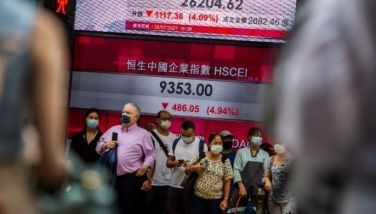Credit Suisse lowers Philippine GDP forecast
MANILA, Philippines - Zurich-based Credit Suisse has slashed the economic growth forecast for the Philippines due to the slowdown in the first half of the year brought about by weak global demand and lack of government spending.
At the same time, the investment bank does not see monetary authorities adjusting key interest rates until end of 2016.
In its Emerging Markets Quarterly report, Credit Suisse economist Michael Wan said the bank trimmed the Philippines’ gross domestic product (GDP) growth forecast to 6.1 percent instead of 6.4 percent this year, but maintained next year’s projection at 6.4 percent.
“We have trimmed our 2015 estimates reflecting the weak first half numbers seen thus far. Nonetheless, moving forward, we expect private consumption spending to underpin the strength in GDP over the next two years, with our analysis suggesting that lower rice and oil price inflation is expected to boost consumption with around two quarters’ lag,” Wan said.
The country’s GDP growth slowed down to 5.3 percent in the first half of the year from 6.4 percent in the same period last year on the back of weak global demand and lack of government spending.
Wan said exports are also expected to show some recovery in the second half following the weak first half performance, reflecting a bounce back after supply disruptions from typhoons.
However, he explained the severe and prolonged El Niño and the associated dry weather would cap improvement in agriculture exports.
According to him, there are some signs of improvement in government spending and disbursement.
“Our expectation is for government spending to improve gradually over the next few quarters, although probably not as much as other analysts expect during an election period,” he added.
Credit Suisse also lowered its inflation forecasts to 1.4 percent instead of 2.2 percent for this year, and to 2.4 percent instead of 3.7 percent for next year due to the benign inflation environment.
Inflation eased to a new record low of 0.6 percent in August from 0.8 percent in July, bringing the average inflation to 1.7 percent in the first eight months of the year amid stable food prices and lower utility rates.
“These partly reflect the lower-than-expected inflation prints that we have already seen in the first half of the year, with inflation falling to a multi-year low of 0.6 percent year-on-year in the latest print,” he said.
The revised forecasts, he explained, reflects a lower assumed path for oil prices and more moderate food and electricity price increases from the El Niño impact.
As such, the bank now expects the Bangko Sentral ng Pilipinas (BSP) to keep interest rates until the end of next year.
“We have removed our expectation for rate hikes in 2016. Partly on the back of the more moderate profile for headline inflation, we have removed our forecast for BSP to hike rates come 2016, and now expect the central bank to keep rates on hold until the end of next year,” Wan said.
He added the risks to monetary policy are nonetheless biased towards easing by tweaking macroprudential measures and reserve requirement ratio as potential first step.
“Nonetheless, we believe that the risk is tilted towards a more dovish central bank at this stage, given the very low and manageable inflation and the moderating credit growth profile,” he said.
The bank added the Philippines has policy space compared to other members of the Association of Southeast Asian Nations (Asean).
- Latest
- Trending


























